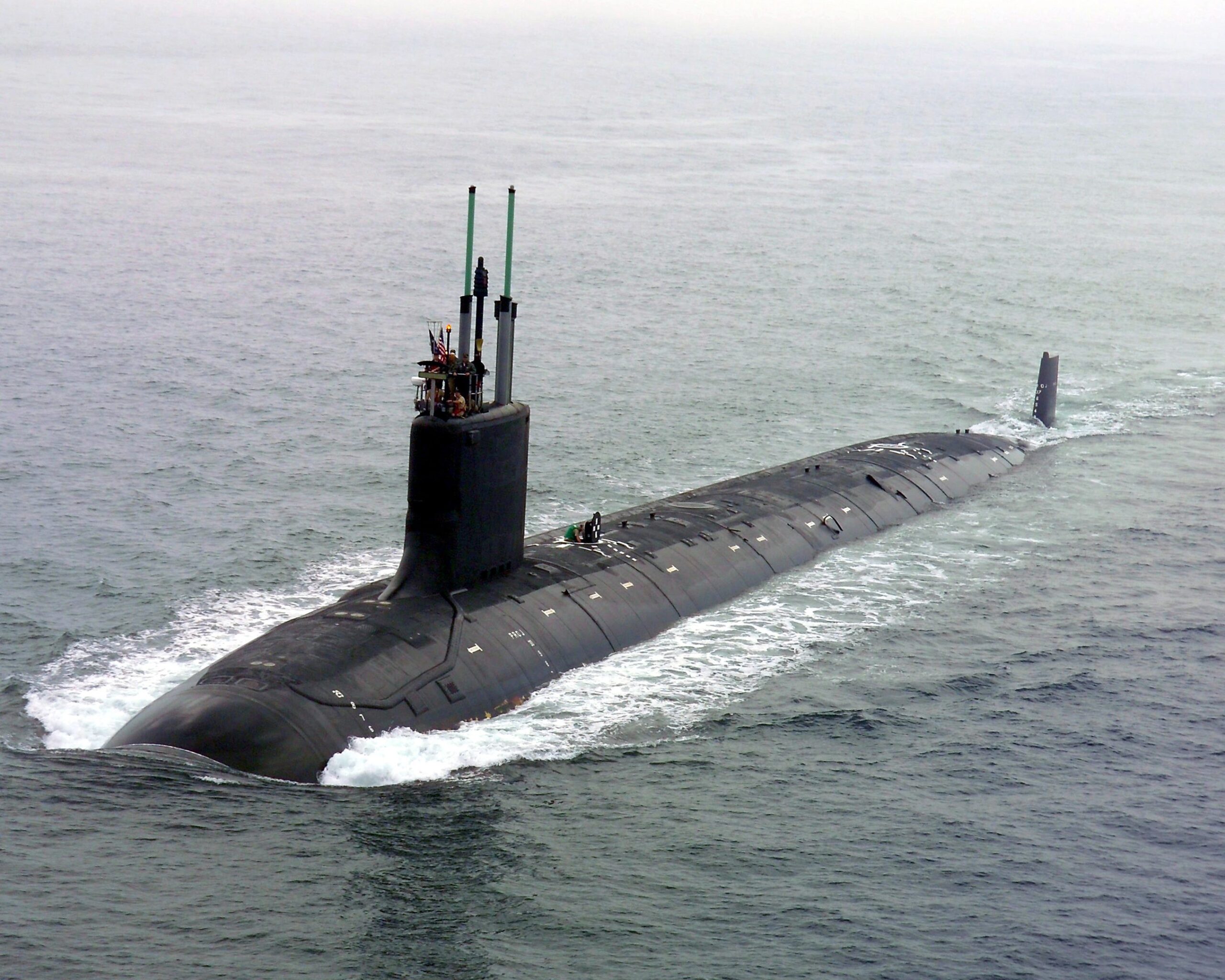2700px-US_Navy_040730-N-1234E-002_PCU_Virginia_SSN_774_returns_to_the_General_Dynamics_Electric_Boat_shipyard-scaled
Autor foto: Domena publiczna



2700px-US_Navy_040730-N-1234E-002_PCU_Virginia_SSN_774_returns_to_the_General_Dynamics_Electric_Boat_shipyard-scaled
Autor foto: Domena publiczna
The China First – The US Defense Budget for FY 2024
Autor: Tomasz Smura
Opublikowano: 17 maja, 2023
Pulaski Policy Paper no 21, May 17, 2023
Introduction
In March 2023 the US Department of Defense (DoD) presented its budget for the Fiscal Year 2024 (September 2023 – September 2024). As the DoD representatives and the overview of the budget emphasised it is “the most strategy-driven request we’ve ever produced from the Department of Defense.” One may probably consider this observation as exaggeration, nevertheless the document’s authors put effort into making sure that the structure of the FY 2024 budget reflects priorities listed in recent National Security Strategy (NSS) and National Defense Strategy (NDS). As NDS indicates “the People’s Republic of China (PRC) is the only competitor with both the intent to reshape the international order and, increasingly, the economic, diplomatic, military, and technological power to do it”, while NDC stated that “the most comprehensive and serious challenge to U.S. national security is the PRC’s coercive and increasingly aggressive endeavour to refashion the Indo-Pacific region and the international system to suit its interests and authoritarian preferences”. It reflects the longstanding shift in the US foreign and security policy (expressed in e.g. the “Pacific pivot” of Obama’s administration and actions of Trump’s administration’s policy targeted at the US trade imbalance with the PRC and Chinese ICT industry) aimed at responding to quickly rising Chinese economic and military power and more assertive policy in the Indo-Pacific region and beyond, as in the face of Russia and other potential challengers weakness China could be the only prospective challenge to the American global superiority. Thus, the overview of the budget emphasises the significance of the challenge of China’s rise, which is to be responded to by largest-ever investments in readiness and procurement as well as the largest investment in research and development.
In order to sustain the US military advantage over China, the Pentagon announced investments in i.e. integrated air and missile defence, operational energy efficiency, air and maritime dominance, and in munitions, including hypersonics. The budget assumed an increase of expenditures for the Pacific Deterrence Initiative and force posture in the Indo-Pacific region, including Guam, Mariana Islands, the Philippines, Japan, and Australia.
In total the DoD budget request for FY2024 equals to USD 842 billion, which makes it 26 billion higher than the FY 2023 budget in regards to base budget (but as no funds for supplements are requested the total budget will be USD 10 billion smaller than the one for FY 2023, if approved) and USD 100 billion higher comparing to FY 2022 base budget. Also the budget request structure refers to the NDS 2022 and is divided into three bigger categories – Integrated Defense (capabilities), Campaigning (readiness, overseas operations etc.) and Building Enduring Advantages (manpower, Research and Development, emerging challenges).
Integrated Defense
Integrated Defense, which is related to the concept indicated in the last NDS (assuming application of multiple deterrence logics – deterrence by denial, deterrence by resilience, deterrence by direct cost imposition, and deterrence through imposing costs on adversaries collectively with Allies) naturally is one of the most important categories in the new US military budget. It combines resources for modernisation and development of i.a. nuclear deterrence, missile defence and capabilities in all military domains (air, land, see, cyber and space).
Traditionally nuclear deterrence was identified as the most important position in terms of the capabilities’ category. It includes programmes such as: LGM-35A Sentinel Intercontinental Ballistic Missile (ICBM, formerly Ground Based Strategic Deterrent), which is expected to replace Cold War-era ICBM Minuteman III starting from late 2020s and Long Range Stand-Off (LRSO) Weapon designated to replace AGM-86B Air Launched Cruise Missile (ALCM) that entered service in 1982. The naval component of the nuclear triad will be reinforced by Columbia-class Ballistic Missile Submarines (SSBN). The program that completed Milestone B (entering the Engineering and Manufacturing Development Phase being considered the official start of a programme) in January 2017 should allow the Navy to retire Ohio-class SSBN starting in 2030. It is accompanied by Life Extension (D5LE) of Submarine-Launched Ballistic Missile (SLBM) Trident II (D5) that will remain in service on both Ohio-class until their retirement and early deployment of Columbia-class boomers. In turn the air-based nuclear components will be based on B-21 Raider Strategic Bomber and F-35A Dual-Capable Aircraft (DCA). The latter is expected to achieve operational nuclear certification in FY 2024.
The high focus in the US defence budget is put on Missile Defeat & Defence. In total FY 2024 budget requests assume USD 29.8 billion for MDD. Among the most important capabilities development programmes that are requested to be financed one can indicate the Next Generation Interceptor (NGI) and fielding of SM-3 Block IIA missiles. The former is expected to enhance the Ground-Based Midcourse Defense (GMD), built on Ground-Based Interceptors (GBI), while the latter, designed to defeat midcourse and Intercontinental Ballistic Missile threats, will improve regional defence systems. The budget request also assumes resources for developing defence against hypersonic threats including Hypersonic and Ballistic Tracking Space Sensor (HBTSS) prototypes and Glide Phase Intercept (GPI) hypersonic defence prototype expected to be delivered in FY 2034. As Aegis Ashore in Poland is scheduled to be delivered in FY 2023, the budget for this project is significantly reduced in the FY 2024 request. Among other important procurements envisaged for FY 2024 one can list SM-3 Block IB, THAAD Interceptors or PAC-3/MSE missiles.
In terms of air power the FY 2024 budget request assumes sources for procurement of fighters: F-35 (83 units), F-15X (24 units), F/A-18E/F (8 units); tankers: KC-46A (15 units); helicopters: CH-53K (12 units), AH–64E (42 units), UH-60 (50 units) and UAVs: MQ-4 (3 units), MQ-9 (5 units), MQ-25 (4 units). In regards to the capabilities for the future USD 2.3 billion is assigned to Next Generation Air Dominance program.
For the US Navy the FY 2024 budget request assumes financing for 6 new combat ships in total, including Virginia-class submarines (expected to replace Ohio-class guided missile submarines starting in 2027), Arleigh Burke destroyers and FFG 62 frigates (2 units each). The continuation of funding for 3 Gerald Ford-class nuclear aircraft carriers (Kennedy CVN 79, Enterprise CVN 80, Doris Miller CVN 81) and 1 LHA America Class amphibious assault ship is also assured.
In regards to the US Army the new budget assumes improvement of the lethality and survivability of the Army’s Infantry and Brigade Combat Teams (BCTs) by modernising weapon platforms, training devices, and combat vehicles. Among concrete capabilities the budget request listed procurement and fielding of 1,419 Next Generation Squad Weapon (NGSW) Automatic Rifles and 17,112 NGSW Rifles, while the Armored Multi-Purpose Vehicle (AMPV) program assumes procurement of 91 vehicles. The FY 2024 budget continues investing in research, development, test, and evaluation for the Remote Combat Vehicles (RCV) and the Optionally Manned Fighting Vehicle (OMFV), which will replace the M-2 Bradley Infantry Fighting Vehicle, within the framework of Next Generation Combat Vehicles line of effort. In turn for the US Marine Corps the budget assigns sources to procure 80 Amphibious Combat Vehicles and 396 Joint Light Tactical Vehicles.
The US Department of Defense highlights also the significance of the ammunition’s procurement, as the US weapon and munitions deliveries to Ukraine have significantly emptied the Army’s stocks, while it needs to remain ready for high-intensity contingencies around Taiwan, Korean Peninsula etc. In this dimension a high emphasis will be put on long-range fires (LRF), which include such systems as Precision Strike Missile (PrSM), Joint Air-to-Surface Standoff Missile (JASSM), Tomahawk Land Attack Missile, Long-Range Anti-Ship Missile (LRASM), and the Maritime Strike Tomahawks (MST). The budget also emphasised multiyear procurement (MYP) contracts and investments in the industrial base as a way to ensure safe munition supplies to the Armed Forces. The space (eg. Space Based Missile Warning Systems) and cyber domains related programmes have also received significant funds.
| Name | Quantity | Appropriated in FY 23 | Requested in FY 24 |
| Sentinel ICBM | – | 3.6 | 4.3 |
| Long Range Stand Off Weapon | – | 1.0 | 1.0 |
| COLUMBIA Class Submarines | – | 6.3 | 6.2 |
| Trident II Missile Mods | – | 1.7 | 1.9 |
| B-21 Bomber | – | 4.8 | 5.3 |
| Missile Defeat and | – | 27.9 | 29.8 |
| F-35 | 83 | 11.9 | 13.6 |
| F-15EX | 24 | 2.7 | 3.0 |
| F/A-18E/F | 8 | 2.1 | 1.8 |
| Next Generation Air Dominance | – | 1.7 | 2.3 |
| KC-46A | 15 | 2.6 | 3.0 |
| CH-53K | 15 | 2.3 | 2.6 |
| MQ-4 | 3 | 0.8 | 1.0 |
| VIRGINIA Class Submarine | 2 | 7.3 | 10.8 |
| ARLEIGH BURKE Destroyer | 2 | 8.2 | 4.8 |
| FORD Aircraft Carrier | 2 | 3.7 | 2.7 |
| FFG 62 | 2 | 1.2 | 2.3 |
| LHA America Class Amphibious Assault | 1.4 | 1.9 | |
| National Security Space Launch | 15 | 2.2 | 3.0 |
| Global Positioning System | – | 1.7 | 1.3 |
| Space Based Missile Warning Systems | – | 4.7 | 5.0 |
Table 1. Major US military procurement programmes
Campaigning
The Campaigning part of the budget request also refers to the 2022 National Defense Strategy, which defines it as sequencing logically-linked military activities across any of the military domains in order to achieve strategy aligned objectives. It is aimed at changing the operating environment in order to benefit the United States and its Allies and partners, simultaneously limiting, frustrating and disrupting hostile efforts, as well as increasing the costs for adversaries to impinge US interests. In practical terms it includes among others investments in bolstering military posture – e.g. infrastructure and prepositioning of equipment – in Asia and Europe. The FY 2024 budget requests as a first mentioned Pacific Deterrence Initiative (PDI) – as NDS 2022 defined China as priority for the DoD – to which USD 9.1 billion was assigned. It assumes investments in infrastructure (USD 2.4 billion); presence (USD 2.9 billion); and logistics, maintenance and prepositioning of equipment, munitions, fuel and materiel (USD 1.1 billion) as well as the capacity and capabilities of Allies and partners in the region (USD 0.5 billion).
In turn European Deterrence Initiative (EDI) aimed at deterring Russia from hostilities against the NATO states was limited (3.6 billion, from USD 4,3 billion in FY 2023), which was a result of successful accomplishment of several significant investments in enhancement of the US military posture in Europe. It includes similar to PDI lines of efforts (balanced US military presence in Europe; increased exercises and training with Allies and partners; enhanced prepositioning of US equipment in Europe; improved infrastructure for greater readiness; and enhanced building of Allies and partner capacity). The FY 2024 budget request includes USD 300 million for the Ukraine Security Assistance Initiative (USAI) to provide support to the Ukrainian Armed Forces. The US DoD efforts in Europe are supported by the US contribution to NATO and NATO Security Investment Programme.
In comparison to the budgets for operations in Asia and Europe the US spending for activities in Middle East (eg. Operation Inherent Resolve) still remains high, although reduced (USD 20.9 billion, from USD 25.8 billion in FY 2023).
Significant part of resources was assigned to readiness (exercises, maintenance, weapon sustainment, infrastructure etc.), especially for the Navy (USD 52.8 billion), ahead of the Air Force (USD 39.9 billion) and the Army (USD 28.8 billion). The budget slightly reduced the size of the Army (951 800 – 954 000 in FY 2023, and 971 501 in FY 2022), increasing the manpower in the Navy and the Air Force.
Investing in the future – building enduring advantages
The last major part of the budget request concentrates mainly on the manpower, investment in the technologies and enhancement of the industrial base. In terms of the human dimension (“Taking Care of our People” priority) the budget assumes e.g. a 5.2 percent pay raise for civilian and military personnel. Resourcing of military families’ support programmes as well as anti-sexual harassment and suicide prevention efforts is also included. In turn in regards to technological edge the budget emphasises the significance of working with the private sector as, according to the document, private capital remains the engine of innovation. The document indicates that the Department is focused on 14 technology areas that will be critical to maintain the US technological advantage (e.g. Directed Energy, Hypersonics, Trusted Al and Autonomy, Quantum Science, Microelectronics). In total the FY 2024 budget request for science and technology (including Basic Research, Applied Research and Advanced Technology Development) is USD 17.8 billion – USD 4.6 billion decrease in comparison to FY-2023. As one of the conclusions from the Russian war against Ukraine the significance of a resilient, diverse, and secure industrial base was emphasised by the budget request. In order to achieve this goal the DoD is expected to continue to use Defense Production Act (DPA) Title III (it identifies areas where critical industrial capacity is lagging or non-existent and fulfil gaps using grants, purchase commitments, loans, or loan guarantees) and the Industrial Base Analysis and Sustainment (IBAS) programs to address industrial base challenges. In total almost USD 2 billion is expected to be spent during FY 2024 for these efforts. Additional USD 1 billion is assigned to the munitions industrial base.
What’s next?
The FY 2024 defence budget request is of course only a part of a wider federal budget request and its release doesn’t conclude the work over the DoD budget for the next fiscal year. The next, but not obligatory (it serves as a blueprint for the appropriation process showing the Congress spending priorities), step in the process is the budget resolution passed by both the House of Representatives and the Senate, but the Congress again missed the April 15 deadline for it. However, both chambers need to pass appropriation bills (12 in total – sometimes combined in omnibus spending bill – the defence appropriation bill is the biggest one), which let the Administration spend resources, by October 1. The negotiations over appropriation bills (the lack of appropriation bills signed by the president, while continuing resolutions allowing for temporary funding of government aren’t passed, means shutdown as the administration is not able to spend money for certain government activities) allow the Congress to influence the Administration priorities and shift spending to other categories. Moreover, the work of the US federal budget is a part of a wider political issue as the US government hits the US 31.4 trillion debt ceiling. Increasing this ceiling demands Congress consent otherwise the Administration will not be able to borrow money, which could mean even the default on debt of the US between July and September 2023 as it would not be able to serve all its financial obligations.
Although this scenario is still quite unrealistic, the Republicans tried to use this opportunity to make the Administration limit its spending on social programmes (until now president Biden refused to negotiate any conditions connected to debt ceiling increase). Nevertheless the Republican proposals of cuts will probably not touch the Armed Forces, although some changes in the DoD priorities are possible.
Conclusions
- The FY 2024 budget request reflects the US priorities listed in the recent National Security Strategy (NSS) and Nationals Defense Strategy (NDS). As these documents identified China as the most important challenge the budget request assumed an increase of expenditures for the Pacific Deterrence Initiative (while resources for operations in Europe and Middle East were reduced) and continued to prioritise the Navy and the Air Force (more important in the Indo-Pacific theatre) over the Army.
- The budget request is still rather the beginning of the work over the DoD budget for the next fiscal year. One should expect some changes to be enforced by the Republicans, especially against the background of disputes over the budget ceiling.
Author: Dr Tomasz Smura, Member of the Board, Programme Director, Casimir Pulaski Foundation






